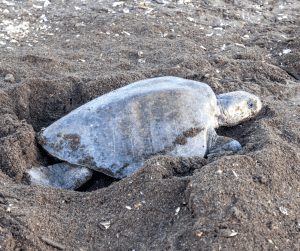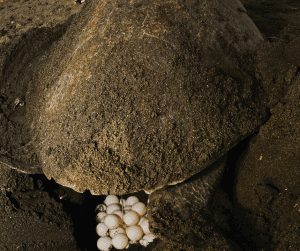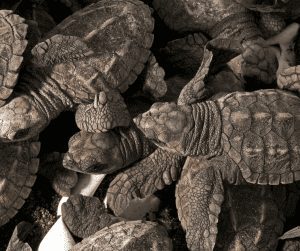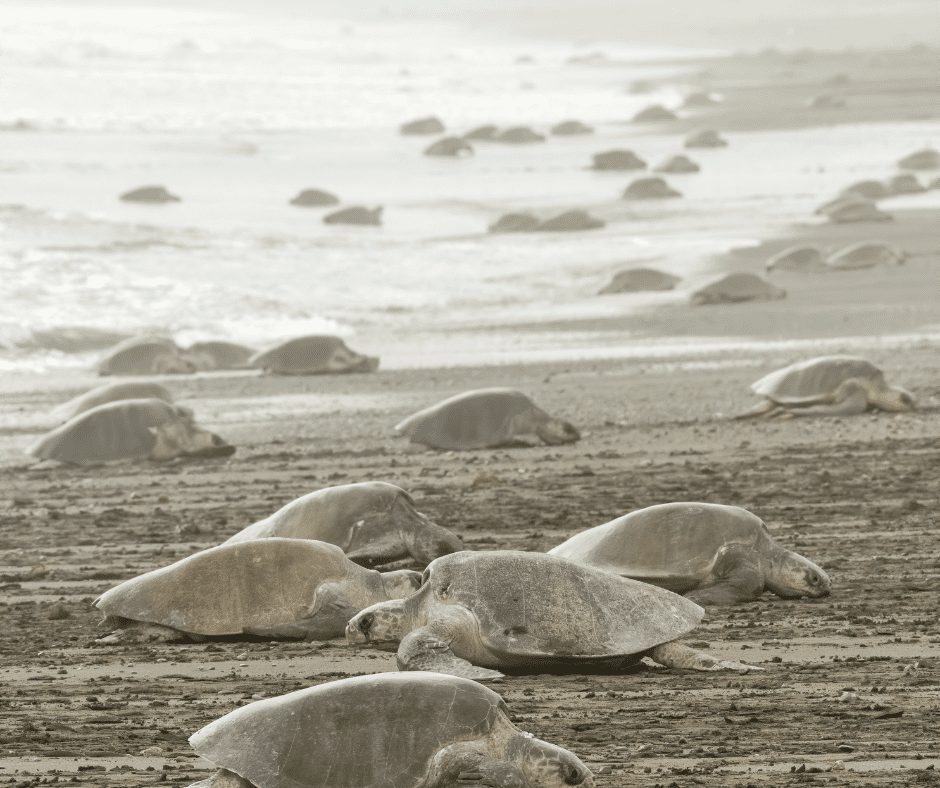Over a five-day period, arribada nesting turtles will lay up to 10 million eggs on Ostional’s beach.
Have you witnessed the arribada of olive ridley green turtles in Ostional, Costa Rica?
This is a must-see if you are here during the opportune time of the year.
Ostional is a small town on the Pacific west coast of Costa Rica; its black volcanic sand beach is the site of one of the largest nesting places for olive ridley turtles. There are only three to five significant sites worldwide with over 100,000 nests, and eight to 10 sites in the world that have attracted only about 10,000 nests.
Ostional’s seashore serves as the backdrop for a biological marvel known as the arribada — Spanish for “arrival.” Sea turtles visit a particular mile of beach in Ostional during the rainy season, usually the week before the new moon, to lay their eggs in the black sand after navigating long distances to return to their original nesting place.

In 1984, the Ostional Wildlife Refuge was formed to preserve this globally significant nesting location for olive ridley sea turtles. The amount of tourist in
teraction with the turtles directly affects their evolution of nesting. Laws are in place to protect the turtles. However, in the past, many have ignored those laws, disturbing the nesting process.
Only olive ridleys and their close relatives, Kemp’s sea turtles — the latter an Atlantic species — synchronize their nests on a large scale referred to as arribadas. There is a gathering of many turtles that congregate offshore a few days or weeks before the mass nesting. The arribada will begin after a few days, prompted by some secret signal. Hundreds of turtles will first appear on the beach, and then a steady stream for the next three to seven days. This is a sight to see. Witnessing such an amazing event is almost spiritual.
Year-round turtle nesting occurs at Ostional, but the rainy season is the busiest. From August through December, arribadas occur monthly, often twice a month, and the number of nesting females is in the hundreds of thousands, as opposed to tens of thousands during the dry season.
Typically, arribadas occur during the darkest nights: a few days before the new moon, when the majority of turtles come to shore between 8 p.m. and 4 a.m.

Largest on record
November 1995 was the largest arribada ever recorded in Ostional, when half a million females arrived.
The turtles usually arrive on the high tide at night, but during an arribada, they begin arriving just after nightfall and continue until early morning.
The turtles, accustomed to life in the sea, drag their massive bodies across the beach until they cross the high tide line. An area that is safe to nest without the tide eroding and washing the eggs away. They dig a nest with their flippers, flicking clouds of sand, and deposit roughly 80 to 100 soft-shelled, white eggs the size of a ping pong ball.
Surprisingly, Ostional is the only beach in the world where it is permissible to collect turtle eggs.
Scientists discovered that most of the eggs laid during the first nights of an arribada are destroyed by other turtles who arrive later to dig their nests in the same spot.

As a result, the Costa Rican government since 1987 has allowed the Ostional community to pick eggs during the first three days of an arribada. In exchange, the locals preserve the turtles, clean up the trash on the beaches, and patrol for poachers 24 hours a day, seven days a week. The town residents take their jobs very seriously as this is their livelihood.
The young turtles hatch at around 45 to 54 days, depending on the incubation temperature, which also determines whether they are male or female. They experience various degrees of success in each of the clutches that are laid in huge groups to maximize their chances of survival.
Straight to the sea
Usually, the turtles hatch at night, but it is possible to see them also during the daytime. The rush to the ocean begins as soon as the hatchlings emerge from the sand. With their eyes barely open, the little turtles sense the air and immediately know which way to go.
 Many from Ostional accompany the hatchlings as they crawl toward the sea, guarding them against dogs and vultures. Small turtles may not be transported to the ocean because they require the run over the sand to grow their lungs. The little turtles are no longer secure once they reach the ocean; the next cast of predators awaits them beneath the surface.
Many from Ostional accompany the hatchlings as they crawl toward the sea, guarding them against dogs and vultures. Small turtles may not be transported to the ocean because they require the run over the sand to grow their lungs. The little turtles are no longer secure once they reach the ocean; the next cast of predators awaits them beneath the surface.
Most hatchlings do not reach maturity, which takes 10 to 15 years. Those who make it, though, will return to their home beach. Even though intrepid turtles may paddle as far as India across the Pacific Ocean, their incredible natural navigation system always directs them back to Ostional, where they will re-lay their eggs at the same spot on the black sand beach as their mother did.
Nature is certainly amazing to witness!JTNDaWZyYW1lJTIwc3JjJTNEJTIyaHR0cHMlM0ElMkYlMkZ3d3cuZ29vZ2xlLmNvbSUyRm1hcHMlMkZlbWJlZCUzRnBiJTNEJTIxMW0xOCUyMTFtMTIlMjExbTMlMjExZDc4NTguNDk0Mzc4MTgxODg2NSUyMTJkLTg1LjcwNjIzNDAyNTcxMzAyJTIxM2Q5Ljk5NjQyODkyMTQxNDQyMiUyMTJtMyUyMTFmMCUyMTJmMCUyMTNmMCUyMTNtMiUyMTFpMTAyNCUyMTJpNzY4JTIxNGYxMy4xJTIxM20zJTIxMW0yJTIxMXMweDhmOWU1MTZkOTAxYjEyNTclMjUzQTB4YzU0MzdjYTdiMDVjMDEzYiUyMTJzR3VhbmFjYXN0ZSUyNTIwUHJvdmluY2UlMjUyQyUyNTIwT3N0aW9uYWwlMjE1ZTAlMjEzbTIlMjExc2VuJTIxMnNjciUyMTR2MTY2NDQ2MTc4OTE2NyUyMTVtMiUyMTFzZW4lMjEyc2NyJTIyJTIwd2lkdGglM0QlMjI2MDAlMjIlMjBoZWlnaHQlM0QlMjI0NTAlMjIlMjBzdHlsZSUzRCUyMmJvcmRlciUzQTAlM0IlMjIlMjBhbGxvd2Z1bGxzY3JlZW4lM0QlMjIlMjIlMjBsb2FkaW5nJTNEJTIybGF6eSUyMiUyMHJlZmVycmVycG9saWN5JTNEJTIybm8tcmVmZXJyZXItd2hlbi1kb3duZ3JhZGUlMjIlM0UlM0MlMkZpZnJhbWUlM0U=Easy online puzzle. Click lower right icon for large screen.
Photo by: Ana Lucia RodriguezJTNDaWZyYW1lJTIwc3JjJTNEJTIyaHR0cHMlM0ElMkYlMkZ3d3cuamlnc2F3cGxhbmV0LmNvbSUyRiUzRnJjJTNEcGxheSUyNmFtcCUzQnBpZCUzRDMxMDdkNDViMDE5MSUyNmFtcCUzQnZpZXclM0RpZnJhbWUlMjIlMjBzdHlsZSUzRCUyMndpZHRoJTNBMTAwJTI1JTNCaGVpZ2h0JTNBMzAwcHglMjIlMjBmcmFtZWJvcmRlciUzRDAlMjBhbGxvd2Z1bGxzY3JlZW4lM0UlM0MlMkZpZnJhbWUlM0UlMEE=Discover more online puzzles at HOWL.






